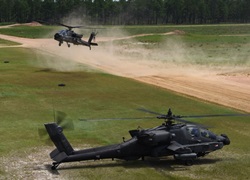
 Fort Stewart, GA
Fort Stewart, GA
July 19, 2017
Story by Capt. Jessica Donnelly
59th Aviation Troop Command
FORT STEWART, GEORGIA – AH-64D Apache pilots with the South Carolina National Guard (SCNG) conducted advanced-level gunnery training in partnership with active duty components during the unit’s annual training July 2017 in preparation for mobilization.
Soldiers with the SCNG, 1-151st Attack Reconnaissance Battalion (ARB) partnered with members of the 3rd Combat Aviation Brigade (CAB), 3/17th Heavy Attack Reconnaissance Squadron (H-ARS), as well as Airmen from the 15th Air Support Operations Squadron (ASOS), and Pennsylvania National Guard (PANG) Soldiers with C Company, 1-151st ARB to conduct qualification training.
“This is the first time we’ve conducted practice qualification gunnery with more than one aircraft on the range at one time,” said U.S. Army Maj. Steven Seigler, 1-151st ARB operations officer. “It is part of the progression from individual aviator, to company-level, and eventually battalion-level collective gunnery proficiency in advanced tables.”
The gunnery training consists of levels, or tables, that progress in complexity as they continue, explained Seigler. They begin with classes, simulators, and practical exercises and continue to develop in order to validate weapon systems on the aircraft and test the individual aviator’s proficiency.
While at Fort Stewart, the pilots progressed through table V: daytime crew qualification engaging moving and stationary targets, VI: nighttime crew qualification, VIII: daytime team qualification, and IX: nighttime team qualification.
“Collective gunnery requires additional skills and [tables] VIII and IX exercise the team skills required to fly in a combat environment,” said Seigler. “Training in this way before a deployment is significant because it is a time to put the finishing touches on team techniques that may be employed during the upcoming deployment.”
U.S. Army Chief Warrant Officer 2 Aaron Sargent, C Company, 1-151st ARB AH-64 Apache pilot, explained how the advancement of each table increases the amount of planning and coordination that goes into it, as well as the amount of communication and decision-making for the pilots.
In previous tables, a script is provided to the aviators and they react based on the guidance given. In table VIII, the Air Mission Commander (AMC) makes decisions on how the teams will react and engage targets.
“Table VIII gives more control to the pilots,” added Sargent. “It allows the AMC and pilots to develop critical thinking skills and make decisions…What we’ll be doing overseas is multiple aircraft will go out as a team, operating together, so this training is more realistic of what we’ll see on the deployment.”
The annual training also allowed for coordination and familiarization with active duty components that the 1-151st ARB will be deployed with. Seigler explained, the 3rd CAB assisted in scheduling ranges at Fort Stewart and pilots with the 3/17th H-ARS conducted the team training alongside the SCNG and PANG Soldiers. Joint terminal attack controller (JTAC) Airmen with the 15th ASOS also worked with the Army units on the range, adding another realistic element of coordination to the training. The JTAC provided script reading for the tables and input on Air Force operations while deployed to joint environments.
In addition to the aviators’ qualifications, the annual training also allowed for other Soldiers within the 1-151st ARB to gain familiarity with their career fields including arming and fueling the Apaches for the range, and conducting aircraft and vehicle maintenance.










